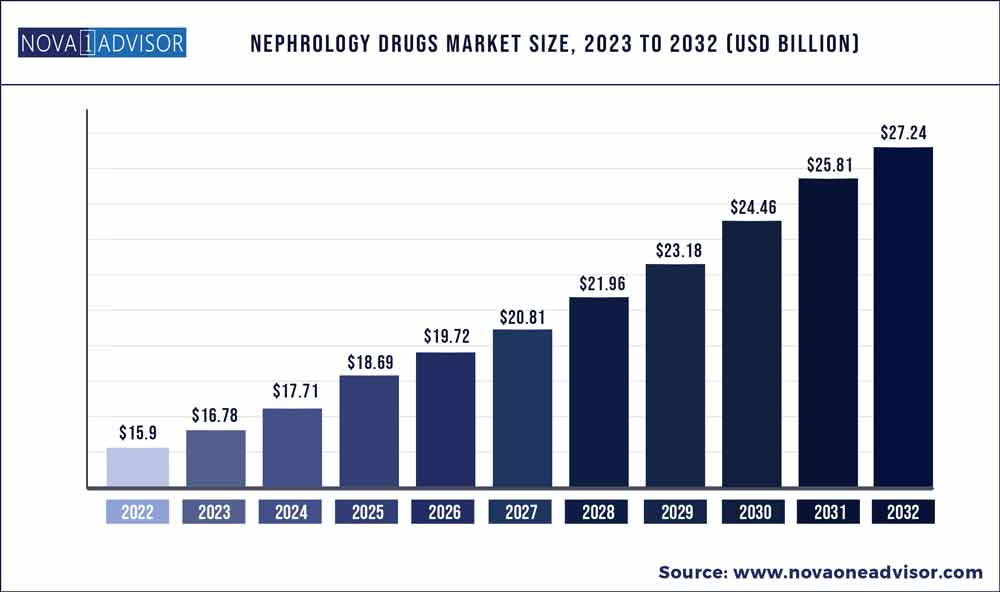The global nephrology drugs market size was estimated at USD 15.9 billion in 2022 and is expected to surpass around USD 27.24 billion by 2032 and poised to grow at a compound annual growth rate (CAGR) of 5.53% during the forecast period 2023 to 2032.

Key Pointers:
- By geography, the North America region captured the largest market share in 2022.
- By drug class, the ACE inhibitors segment generated the major market share in 2022.
- By route of administration, segment is expected to have the fastest market growth rate.
- By distribution channel, the hospital pharmacies segment dominates the global market.
Nephrology Drugs Market Report Scope
|
Report Coverage
|
Details
|
|
Market Size in 2023
|
USD 16.78 Billion
|
|
Market Size by 2032
|
USD 27.24 Billion
|
|
Growth Rate From 2023 to 2032
|
CAGR of 5.53%
|
|
Base Year
|
2022
|
|
Forecast Period
|
2023 to 2032
|
|
Segments Covered
|
By Drug Class, By Route of Administration and By Distribution Channel
|
|
Market Analysis (Terms Used)
|
Value (US$ Million/Billion) or (Volume/Units)
|
|
Regional Scope
|
North America; Europe; Asia Pacific; Central and South America; the Middle East and Africa
|
|
Key Companies Profiled
|
AstraZeneca, AbbVie Inc., Akebia Therapeutics, Inc., Amgen Inc., F. Hoffmann-La Roche, FibroGen Inc., Johnson & Johnson Inc., Pfizer Inc., Teva Pharmaceutical Industries Limited, Reata Pharmaceuticals, Inc., GlaxoSmithKline plc., Ardelyx, Inc., Boehringer Ingelheim International GmbH, Novo Nordisk A/S, Novartis AG and Others.
|
Factors such as increase in kidney failure cases, rise in adaptation of unhealthy lifestyle, surge in prevalence of chronic nephrology diseases, rise in geriatric population, increase in demand for diagnostic tests, surge in excessive alcohol consumption, and rise in obese population drive the growth of the nephrology drugs.
Emerging technology in developing countries, increase in demand for targeted & immunotherapies, development in diagnosis & renal treatment, rise in R&D activities to improve drugs & launch of novel drugs, and joint ventures & agreement between key market players boost the growth of the nephrology drugs market. However, high treatment costs and lack of awareness about kidney disorders hinder the growth of the market. On the contrary, government initiatives for regulatory approvals and favorable insurance policies are expected to offer lucrative opportunities for market expansion.
Nephron is a major part of the kidney that plays an important role of filtration of blood. Diabetes and hypertension both affect the nephron functions and have the potential to damage nephrons. Furthermore, this affects the filtration rate of nephrons. Chronic kidney disorders such as kidney stones, kidney failure, and kidney cancer are treated with Nephrology drugs. Such disorders gradually deteriorate the functioning of the kidney. Invokana, Phoslo, Renvela, Sensipar, and Procrit are some examples of drugs used in the treatment of nephrology.
The outbreak of COVID-19 has disrupted workflows in the healthcare sector across the world. The disease has forced a number of industries to shut their doors temporarily, including several sub-domains of healthcare. The overall impact of the COVID-19 pandemic remained negative for key players in the nephrology drugs industry. The COVID-19 pandemic has stressed healthcare system in the world. COVID-19 has caused clinical trial delays for nephrology drugs and has also resulted in low usage of these drugs. Due to worldwide lockdowns, production has been halted which is causing supply chain issues. The COVID-19 pandemic is a major inhibitor for the growth of nephrology drug trials during the period. The coronavirus outbreak is disrupting clinical research across the globe and has affected the management of ongoing trials and planning of future trials. However, market players and research institutes are focusing on initiating clinical trials associated with COVID-19 to understand the effects of chronic kidney disease treatment drugs on patients suffering with COVID-19. Therefore, the COVID-19 pandemic is expected to significantly have a positive impact on the growth of the global next-generation sequencing informatics market.
Some of the prominent players in the Nephrology Drugs Market include:
- AstraZeneca
- AbbVie Inc.
- Akebia Therapeutics, Inc.
- Amgen Inc.
- F. Hoffmann-La Roche
- FibroGen Inc.
- Johnson & Johnson Inc.
- Pfizer Inc.
- Teva Pharmaceutical Industries Limited
- Reata Pharmaceuticals, Inc.
- GlaxoSmithKline plc.
- Ardelyx, Inc.
- Boehringer Ingelheim International GmbH
- Novo Nordisk A/S
- Novartis AG
Segments Covered in the Report
This report forecasts revenue growth at global, regional, and country levels and provides an analysis of the latest industry trends in each of the sub-segments from 2018 to 2032. For this study, Nova one advisor, Inc. has segmented the global Nephrology Drugs market.
By Drug Class
- ACE Inhibitors
- Angiotensin Receptor Blockers (ARBs)
- B-Blockers
- Calcium Channel Blockers
- Loop Diuretics
- Erythropoiesis-Stimulating Agents (ESAs)
- Phosphate Binders
- Others
By Route of Administration
- Oral
- Subcutaneous
- Intravenous
By Distribution Channel
- Hospital Pharmacies
- Retail Pharmacies
- Online Pharmacies
By Region
- North America
- Europe
- Asia-Pacific
- Latin America
- Middle East & Africa (MEA)

